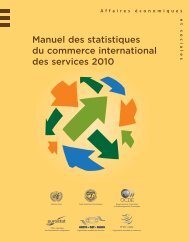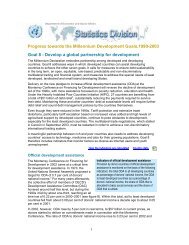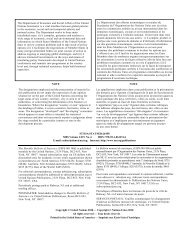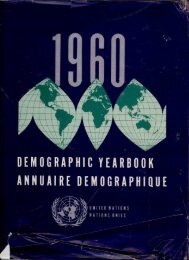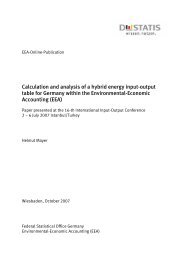dime NOTE The designations employed and the presentation of ...
dime NOTE The designations employed and the presentation of ...
dime NOTE The designations employed and the presentation of ...
- No tags were found...
You also want an ePaper? Increase the reach of your titles
YUMPU automatically turns print PDFs into web optimized ePapers that Google loves.
Data definitionsindustrial production indices: Laspeyres’s index number <strong>of</strong>total value-added in all industrial production, where valueadded is <strong>the</strong> value <strong>of</strong> output less <strong>the</strong> values <strong>of</strong> bothintermediate consumption <strong>and</strong> consumption <strong>of</strong> fixed capital.industrial products: Goods produced by resident institutionalunits in industries <strong>of</strong> mining, manufacturing <strong>and</strong> electricity,gas <strong>and</strong> water (22, para. 6.238).infant deaths: Infant deaths under one year <strong>of</strong> age (20, ID3).See also deaths rates, crude.intermediate goods: Goods consumed as inputs by a process<strong>of</strong> production, excluding fixed assets (22, para. 6.147).iron ore: CPC Vers. 1.1 (7) group 141: Iron ores <strong>and</strong>concentrates, o<strong>the</strong>r than roasted iron pyrites.Llignite: Coal with a low degree <strong>of</strong> coalification that hasretained <strong>the</strong> anatomical structure <strong>of</strong> <strong>the</strong> vegetable matterfrom which it was formed (6). CPC Vers. 1.1 (7): Lignite,whe<strong>the</strong>r or not agglomerated (class 1103).livestock: All domestic animals irrespective <strong>of</strong> <strong>the</strong>ir age <strong>and</strong><strong>the</strong> place or purpose <strong>of</strong> <strong>the</strong>ir breeding.Mmanufacturing: Comprises tabulation category D <strong>and</strong>divisions 15-37 in <strong>the</strong> International St<strong>and</strong>ard IndustrialClassification <strong>of</strong> All Economic Activities, Revision 3. It isdefined as <strong>the</strong> physical or chemical transformation <strong>of</strong>materials or components into new products, whe<strong>the</strong>r <strong>the</strong>work is performed by power-driven machines or by h<strong>and</strong>,whe<strong>the</strong>r it is done in a factory or in <strong>the</strong> worker's home, <strong>and</strong>whe<strong>the</strong>r <strong>the</strong> products are sold at wholesale or retail.Included are assembly <strong>of</strong> component parts <strong>of</strong> manufacturedproducts <strong>and</strong> recycling <strong>of</strong> waste materials (16).mining <strong>and</strong> quarrying: Extraction, dressing <strong>and</strong> beneficiating<strong>of</strong> minerals occurring naturally: Solids, such as coal <strong>and</strong>ores; liquids, such as crude petroleum; <strong>and</strong> gases, such asnatural gas. Mining includes underground <strong>and</strong> surfacemines, quarries <strong>and</strong> wells <strong>and</strong> all supplemental activities fordressing <strong>and</strong> beneficiating ores <strong>and</strong> o<strong>the</strong>r crude materials,such as crushing, screening, washing, cleaning, gradingmilling, flotation, melting, pelleting, topping <strong>and</strong> o<strong>the</strong>rpreparations needed to render <strong>the</strong> material marketable (17,p.27).money, quasi-money: Money comprises transferable dem<strong>and</strong>deposits <strong>of</strong> monetary authorities <strong>and</strong> deposit money banks(“M1”), o<strong>the</strong>r than those <strong>of</strong> <strong>the</strong> central government, <strong>and</strong>currency outside banks plus, where applicable, privatesector dem<strong>and</strong> deposits with <strong>the</strong> postal checking system <strong>and</strong>with <strong>the</strong> Treasury. Quasi-money comprises time, savings,<strong>and</strong> foreign currency deposits <strong>of</strong> resident sectors o<strong>the</strong>r thancentral government. Money plus quasi-money is frequentlycalled “M2” (4, Introduction, sect. 4). See also reservemoney.motor vehicles: CPC Vers. 1.1 (7): Motor cars <strong>and</strong> o<strong>the</strong>rvehicles principally designed for <strong>the</strong> transport <strong>of</strong> persons(except public-transport type vehicles specially designed fortravelling on snow, <strong>and</strong> golf cars <strong>and</strong> similar vehicles(subclass 49113).motor vehicles, new, registration: Registrations <strong>of</strong> newpassenger cars <strong>and</strong> commercial motor vehicles put intocirculation for <strong>the</strong> first time (21, p. 253).Nnatural gas: A mixture <strong>of</strong> hydrocarbon compounds <strong>and</strong> smallquantities <strong>of</strong> non-hydrocarbons existing in <strong>the</strong> gaseousphase or in solution with oil in natural undergroundreservoirs (12). CPC Vers. 1.1 (7): Natural gas, liquifiedor in <strong>the</strong> gaseous state (class 1202).newsprint: Bleached, unsized or slack-sized printing paper,without coating, <strong>of</strong> <strong>the</strong> type usually used for newspaper;weight from 45-60 grams per square metre, usually with atleast 70 per cent <strong>of</strong> <strong>the</strong> weight <strong>of</strong> fibrous material derivedfrom mechanical pulp (21, p. 140). CPC Vers. 1.1 (7):Newsprint (subclass 32121).non-residential building: A building where half or more <strong>of</strong><strong>the</strong> floor area is intended for o<strong>the</strong>r than dwelling purposes(21, p. 168).Ppetroleum, crude: CPC Vers.1.1 (7): Petroleum oils <strong>and</strong> oilsobtained from bituminous materials, o<strong>the</strong>r than crude;preparations not elsewhere classified containing by weight70 per cent or more <strong>of</strong> <strong>the</strong>se oils, such oils being <strong>the</strong> basicconstituents <strong>of</strong> <strong>the</strong> preparations (group 333). Petroleumoils <strong>and</strong> oils obtained from bituminous minerals, crude(class 1201).pig iron including foundry: Various mineral aggregates fromwhich iron metal is obtained by <strong>the</strong> conversion <strong>of</strong> variousiron ores by reduction ei<strong>the</strong>r into pig iron, in blast furnacesor electric furnaces, or into a spongy form (sponge iron) orinto lumps by various direct reduction processes. Iron ore ismeasured by <strong>the</strong> weight <strong>of</strong> <strong>the</strong> ore <strong>and</strong> may contain varyingconcentrations <strong>of</strong> metal. CPC Vers. 1.1 (7), (group 411):Basic iron <strong>and</strong> steel.population, estimate <strong>of</strong> total: <strong>The</strong> total population <strong>of</strong> acountry may comprise ei<strong>the</strong>r all usual residents <strong>of</strong> <strong>the</strong>country (de jure population) or all persons present in <strong>the</strong>country (de facto population) at <strong>the</strong> time <strong>of</strong> <strong>the</strong> census. Forpurposes <strong>of</strong> international comparisons, <strong>the</strong> de factodefinition is recommended (18).population, <strong>of</strong>ficial mid-year estimates: Estimates <strong>of</strong> <strong>the</strong> defacto population on 1 July provided by national statistical<strong>of</strong>fices (10, notes to table 3).producer price indices: <strong>The</strong> amount receivable by <strong>the</strong>producer from <strong>the</strong> purchaser for a unit <strong>of</strong> a good or serviceproduced as output minus any value-added tax, or similardeductible tax, invoiced to <strong>the</strong> purchaser. It includes anytransport charges invoiced separately by <strong>the</strong> producer (22,para. 6.205). In principle, <strong>the</strong> PPI should include serviceindustries, but in practice it is limited to <strong>the</strong> domesticagricultural <strong>and</strong> industrial sectors. <strong>The</strong> prices should befarm-gate prices for <strong>the</strong> agricultural sector <strong>and</strong> ex-factoryfor <strong>the</strong> industrial sector. <strong>The</strong> indices are computed using <strong>the</strong>October 2010 – octobre 2010 323



